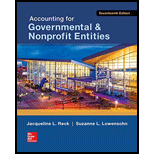
Accounting for Governmental & Nonprofit Entities
17th Edition
ISBN: 9780078025822
Author: Jacqueline L. Reck James E. Rooks Distinguished Professor, Suzanne Lowensohn, Earl R Wilson
Publisher: McGraw-Hill Education
expand_more
expand_more
format_list_bulleted
Concept explainers
Textbook Question
Chapter 12, Problem 15.3EP
Which of the following steps would not usually be part of the budgeting process?
- a. Heads of operating departments prepare budget requests.
- b. The chief executive (mayor or city manager, as appropriate) formally adopts the budget, thus giving it the force of law.
- c. One or more public budget hearings are held.
- d. The budget officer and other central administrators review and make adjustments to department requests.
Expert Solution & Answer
Want to see the full answer?
Check out a sample textbook solution
Students have asked these similar questions
I want to correct answer general accounting question
Hello teacher please help me with accounting questions
Do fast answer of this accounting questions
Chapter 12 Solutions
Accounting for Governmental & Nonprofit Entities
Ch. 12 - Are governments and not-for-profit organizations...Ch. 12 - What is the difference between two types of...Ch. 12 - Describe the advantages of performance budgeting...Ch. 12 - Prob. 4QCh. 12 - Identify some essential components of the annual...Ch. 12 - Prob. 6QCh. 12 - Prob. 7QCh. 12 - Prob. 8QCh. 12 - Prob. 9QCh. 12 - Prob. 10Q
Ch. 12 - Prob. 13CCh. 12 - Budgets of government entities a. Are integrated...Ch. 12 - Which of the following statements regarding...Ch. 12 - Which of the following steps would not usually be...Ch. 12 - The budgeting principle in generally accepted...Ch. 12 - Prob. 15.5EPCh. 12 - An approach to budgeting that requires the very...Ch. 12 - Which of the following does not represent a...Ch. 12 - Prob. 15.8EPCh. 12 - Prob. 15.9EPCh. 12 - Prob. 15.10EPCh. 12 - The police chief of the Town of Meridian submitted...Ch. 12 - Prob. 17EPCh. 12 - Prob. 18EPCh. 12 - Prob. 19EPCh. 12 - Prob. 20EPCh. 12 - The U.S. Office of Management and Budget (OMB)...
Knowledge Booster
Learn more about
Need a deep-dive on the concept behind this application? Look no further. Learn more about this topic, accounting and related others by exploring similar questions and additional content below.Similar questions
arrow_back_ios
SEE MORE QUESTIONS
arrow_forward_ios
Recommended textbooks for you
- Principles of Accounting Volume 2AccountingISBN:9781947172609Author:OpenStaxPublisher:OpenStax College

Principles of Accounting Volume 2
Accounting
ISBN:9781947172609
Author:OpenStax
Publisher:OpenStax College
What is Budgeting? | Budgetary control | Advantages & Limitations of Budgeting; Author: Educationleaves;https://www.youtube.com/watch?v=INnPo0QPXf4;License: Standard youtube license